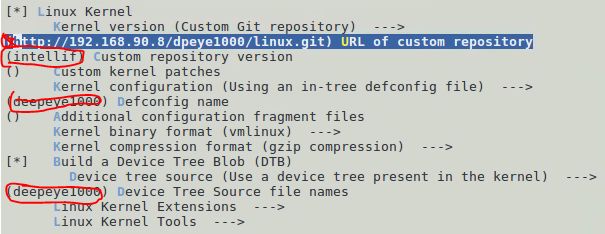buildroot详解和分析
buildroot是Linux平台上一个构建嵌入式Linux系统的框架。
整个Buildroot是由Makefile脚本和Kconfig配置文件构成的。
可以和编译Linux内核一样,通过buildroot配置,menuconfig修改,编译出一个完整的可以直接烧写到机器上运行的Linux系统软件(包含boot、kernel、rootfs以及rootfs中的各种库和应用程序)。
buildboot也可以单独通过配置和使用交叉编译链工具来实现制作一个Linux文件系统。
buildroot准备工作
下载地址: http://buildroot.uclibc.org/download.html(官网) ,
https://github.com/buildroot/buildroot(github) 。
硬件支持: Linux系统的电脑或者装有Linux虚拟机的电脑 。
解压过程:
- 选择好相应的目录,将下载的压缩包放置在其下
- 解压:
tar -xzvf buildroot-2017.02.9.tar.gz
大致使用流程:
- 选择一个defconfig;
- 根据需要配置buildroot;
- 编译buildroot;
- 在目标板上运行buildroot构建的系统。
buildroot目录介绍
解压之后,我们可以看到以下的目录情况:
├── arch: 存放CPU架构相关的配置脚本,如arm/mips/x86,这些CPU相关的配置,在制作工具链时,编译uboot和kernel时很关键.
├── board 存放了一些默认开发板的配置补丁之类的
├── boot
├── CHANGES
├── Config.in
├── Config.in.legacy
├── configs: 放置开发板的一些配置参数.
├── COPYING
├── DEVELOPERS
├── dl: 存放下载的源代码及应用软件的压缩包.
├── docs: 存放相关的参考文档.
├── fs: 放各种文件系统的源代码.
├── linux: 存放着Linux kernel的自动构建脚本.
├── Makefile
├── Makefile.legacy
├── output: 是编译出来的输出文件夹.
│ ├── build: 存放解压后的各种软件包编译完成后的现场.
│ ├── host: 存放着制作好的编译工具链,如gcc、arm-linux-gcc等工具.
│ ├── images: 存放着编译好的uboot.bin, zImage, rootfs等镜像文件,可烧写到板子里, 让linux系统跑起来.
│ ├── staging
│ └── target: 用来制作rootfs文件系统,里面放着Linux系统基本的目录结构,以及编译好的应用库和bin可执行文件. (buildroot根据用户配置把.ko .so .bin文件安装到对应的目录下去,根据用户的配置安装指定位置)
├── package:下面放着应用软件的配置文件,每个应用软件的配置文件有Config.in和soft_name.mk,其中soft_name.mk(这种其实就Makefile脚本的自动构建脚本)文件可以去下载应用软件的包。
├── README
├── support
├── system
└── toolchain
buildroot配置
通过make xxx_defconfig来选择一个defconfig,这个文件在config目录下。
然后通过make menuconfig进行配置:
Target options --->选择目标板架构特性。
Build options --->配置编译选项。
Toolchain ---> 配置交叉工具链,使用buildroot工具链还是外部提供。
System configuration ---> 系统配置
Kernel ---> 配置内核
Target packages --->
Filesystem images --->配置文件系统
Bootloaders --->硬件启动程序
Host utilities --->
Legacy config options --->
make命令解析
通过make help可以看到buildroot下make的使用细节,包括对package、uclibc、busybox、linux以及文档生成等配置:
Cleaning:
clean - delete all files created by build----------------------------------------清理
distclean - delete all non-source files (including .config)
Build:
all - make world----------------------------------------------编译整个系统
toolchain - build toolchain------------------------------------------编译工具链
Configuration:
menuconfig - interactive curses-based configurator--------------------------------对整个buildroot进行配置
savedefconfig - Save current config to BR2_DEFCONFIG (minimal config)----------------保存menuconfig的配置
Package-specific:-------------------------------------------------------------------------------对package配置
- Build and install and all its dependencies---------------------单独编译对应APP
-source - Only download the source files for
-extract - Extract sources
-patch - Apply patches to
-depends - Build 's dependencies
-configure - Build up to the configure step
-build - Build up to the build step
-show-depends - List packages on which depends
-show-rdepends - List packages which have as a dependency
-graph-depends - Generate a graph of 's dependencies
-graph-rdepends - Generate a graph of 's reverse dependencies
-dirclean - Remove build directory-----------------------------------------清除对应APP的编译目录
-reconfigure - Restart the build from the configure step
-rebuild - Restart the build from the build step--------------------------------单独重新编译对应APP
busybox:
busybox-menuconfig - Run BusyBox menuconfig
uclibc:
uclibc-menuconfig - Run uClibc menuconfig
linux:
linux-menuconfig - Run Linux kernel menuconfig-----------------------------------------配置Linux并保存设置
linux-savedefconfig - Run Linux kernel savedefconfig
linux-update-defconfig - Save the Linux configuration to the path specified
by BR2_LINUX_KERNEL_CUSTOM_CONFIG_FILE
Documentation:
manual - build manual in all formats
manual-pdf - build manual in PDF
graph-build - generate graphs of the build times----------------------------------对编译时间、编译依赖、文件系统大小生成图标
graph-depends - generate graph of the dependency tree
graph-size - generate stats of the filesystem size
buildroot工作原理
Buildroot原则上是一个自动构建框架,虽然说u-boot、linux kernel这些经典的开源软件包的构建脚本,官方社区都在帮你实现了,但是有时候你还是需要加入你自己特有的app_pkg软件包,用以构建自己的应用。
buildroot的编译流程是先从dl/xxx.tar下解压出源码到output/build/xxx,然后它利用本身的配置文件(如果有的话)覆盖output/build/xxx下的配置文件,在开始编译连接完成后安装到output/相应文件夹下。
Buildroot提供了函数框架和变量命令框架,采用它的框架编写的app_pkg.mk这种Makefile格式的自动构建脚本,将被package/pkg-generic.mk 这个核心脚本展开填充到buildroot主目录下的Makefile中去。最后make all执行Buildroot主目录下的Makefile,生成你想要的image。
package/pkg-generic.mk中通过调用同目录下的pkg-download.mk、pkg-utils.mk文件,已经帮你自动实现了下载、解压、依赖包下载编译等一系列机械化的流程。你只要需要按照格式写Makefile脚app_pkg.mk,填充下载地址,链接依赖库的名字等一些特有的构建细节即可。
总而言之,Buildroot本身提供构建流程的框架,开发者按照格式写脚本,提供必要的构建细节,配置整个系统,最后自动构建出你的系统。

buildroot/packages里面有丰富的应用软件的配置文件,可以通过make menuconfig,出现图形化界面进行选择丰富的开源软件包的编译和构建。
对buildroot的配置通过Config.in串联起来,起点在根目录Config.in中:
| 配置选项 | Config.in位置 |
|---|---|
| Target options | arch/Config.in |
| Build options | Config.in |
| Toolchain | toolchain/Config.in |
| System configuration | system/Config.in |
| Kernel | linux/Config.in |
| Target packages | package/Config.in |
| Target | packages->Busybox |
| Filesystem images | fs/Config.in |
| Bootloaders | boot/Config.in |
| Host utilities | package/Config.in.host |
| Legacy config options | Config.in.legacy |
配置Kernel内核
对Linux内核的配置包括两部分:通过make menuconfig进入Kernel对内核进行选择,通过make linux-menuconfig对内核内部进行配置。
内核配置
进入buildroot目录,输入make menuconfig,选然后选择Kernel进行配置,如图:

- “Kernel version”选择内核的版本;
- “Defconfig name”选择内核config文件;
- “Kernel binary formant”选择内核格式;
- “Device tree source file names”选择DT文件;
- “Linux Kernel Tools”中选择内核自带的工具,比如perf;
- 可以选择“Custom Git repository”来指定自己的Git库,在“Custom repository version”中指定branch名称。
- 选择“Using an in-tree defconfig file”,在“Defconfig name”中输入defconfig名称,注意不需要末尾_defconfig。
- 选择“Use a device tree present in the kernel”,在“Device Tree Source file names”中输入dts名称,不需要.dts扩展名。
- “Kernel binary format”可以选择vmlinux或者uImage。
uImage是uboot专用的映像文件,它是在zImage之前加上一个长度为64字节的“头”,说明这个内核的版本、加载位置、生成时间、大小等信息;其0x40之后与zImage没区别。
zImage是ARM Linux常用的一种压缩映像文件,uImage是U-boot专用的映像文件,它是在zImage之前加上一个长度为0x40的“头”,说明这个映像文件的类型、加载位置、生成时间、大小等信息。
vmlinux编译出来的最原始的内核elf文件,未压缩。
zImage是vmlinux经过objcopy gzip压缩后的文件, objcopy实现由vmlinux的elf文件拷贝成纯二进制数据文件。
uImage是U-boot专用的映像文件,它是在zImage之前加上一个长度为0x40的tag。
选择vmlinux和uImage的区别在于:
PATH="/bin..."
BR_BINARIES_DIR=/home/.../output/images /usr/bin/make -j9
HOSTCC="/usr/bin/gcc"
HOSTCFLAGS=""
ARCH=csky
INSTALL_MOD_PATH=/home/.../output/target
CROSS_COMPILE="/home/.../output/host/bin/csky-abiv2-linux-"
DEPMOD=/home/.../output/host/sbin/depmod
INSTALL_MOD_STRIP=1 -C /home/.../linux uImage
如果是vmlinux,在结尾就是vmlinux。
内核内部配置
通过make linux-menuconfig可以对内核内部细节进行配置。
让Linux内核带符号表:
CONFIG_COMPILE_TEST is not set
CONFIG_DEBUG_INFO=y
配置文件系统
- 对目标板文件系统内容进行配置主要通过make menuconfig进入Target packages进行。
- 在Filesystem images中配置文件系统采用的格式,以及是否使用RAM fs。
配置Uboot
使用uboot作为bootloader,需要进行一些配置。
在选中U-boot作为bootloader之后,会弹出一系列相关配置。
